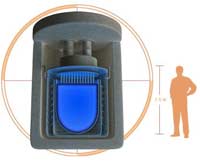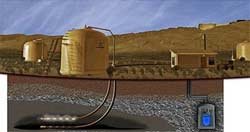A small portable nuclear reactor about the size of a phone booth could be the key to securing America's energy future. The Hyperion nuclear battery is filled with an uranium hydride core and surrounded by a hydrogen atmosphere. The self sufficient nuclear generator is simply buried underground and hooked up to a steam turbine it generates enough electricity to power a 25,000-home community for at least five years.
The nuclear battery cannot overheat and has no mechanical function to maintain. The company is expecting to produce 4000 units in the next 3 years, which could provide 100GW of power, equal to about 20% of America's total energy usage.
Each mini reactor can produce 27 megawatts worth of thermal energy and it is totally self-contained, involves no moving parts and, therefore, doesn’t require a human operator.
“In fact, we prefer to call it a ‘drive’ or a ‘battery’ or a ‘module’ in that it’s so safe,” Hyperion spokeswoman Deborah Blackwell says. “Like you don’t open a double-A battery, you just plug [the reactor] in and it does its chemical thing inside of it. You don’t ever open it or mess with it.”
LANL scientist Otis Peterson filed the patent for the nuclear fission reactor in 2003. In theory, the reactor uses uranium crystals and hydrogen isotopes to create an internal, self-regulating balance. Because it’s so new, anti-nuclear power activists aren’t quite sure what to make of it yet.
The Federal Laboratory Consortium for Technology Transfer a group of 700 labs, set up by Congress to promote “technology transfer” activities between the public and private sectors, honored Peterson’s invention as an “Outstanding Technology Development” in October 2003 at its conference in Hawaii. Now retired from LANL, Peterson has become the chief scientist for Hyperion, Blackwell says.
Blackwell is a director of Purple Mountain Ventures, a self-described “adventure capital” firm specializing in commercial development of LANL technology. Purple Mountain also is the financial backer behind The Company for Information Visualization and Analysis (CIVA), a local company developing LANL pandemic modeling software. Hyperion’s reactor, though, has the potential to solve the energy crisis, according to Blackwell.
“The lab is doing a lot of work on oil shales and oil sands, but there’s no way to get power to those facilities,” Blackwell says. “So, this nuclear battery would be brought in and that would provide the power to run a small city of industrial use.”
Blackwell also envisions that the battery could be used at military bases, as well as in the developing world, where poverty is a product of a lack of electricity and clean drinking water.

